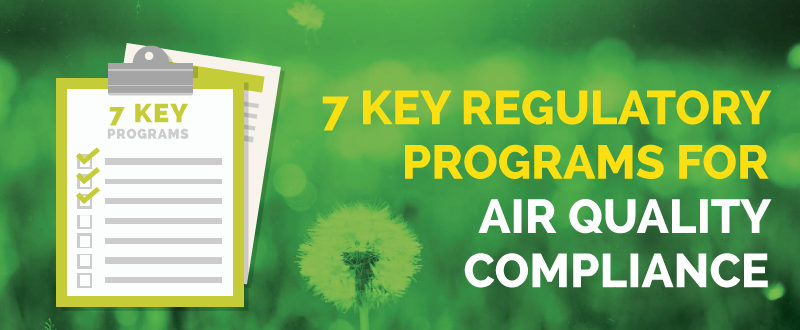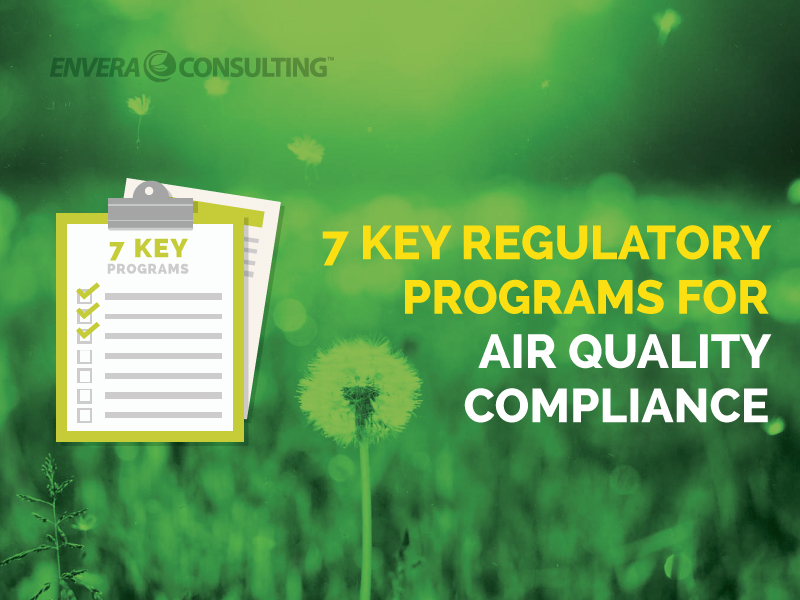

At their core, air quality regulations exist to achieve one common goal. From the federal Clean Air Act:
One of the goals of the Act was to set and achieve NAAQS [National Ambient Air Quality Standards] in every state by 1975 in order to address the public health and welfare risks posed by certain widespread air pollutants.
Such a wide-reaching ambition has a lot of moving parts, which are managed by the country’s many regulatory programs. Depending where your facility is located, you’ll have to comply with any number of local, state, and federal rules, each of which falls into one of three areas:
- Ensuring compliance
- Reducing emissions
- Quantifying emissions
In most cases, the seven compliance programs listed below account for 80 percent of the entire air program of any facility located within the South Coast Air Quality Management District (SCAQMD). Mileage will vary depending on the size of the overall facility (i.e., a smaller facility will generally be subject to fewer of these programs than will a larger one).
1. Title V Compliance Program
The SCAQMD Title V program, which grew out of the 1990 amendments to the Clean Air Act, has one key purpose: improving compliance. To achieve this, the program has a number of requirements (three are provided here). First, Title V requires facilities to submit periodic reports of non-compliance to the SCAQMD and to certify the compliance status for the overall facility. Second, Title V required regulatory agencies to issue a new type of permit, called a facility permit, that includes all applicable rules. Lastly, Title V gave private citizens and the EPA more influence in the permitting process, since both have the ability to provide comments on a permit that is about to be issued by the SCAQMD.
The SCAQMD rules that pertain to Title V can be found in Regulation XXX.
2. Regional Clean Air Incentives Market (RECLAIM) Program
The SCAQMD RECLAIM program was first adopted in 1993, and was one of the first “market-based” compliance programs for reducing air emissions. The program was designed to give facilities flexibility in how to meet air emission standards, without specifically identifying one specific technology. Under this program, covered facilities (i.e., ones that are part of the RECLAIM program) must install emission-monitoring equipment and submit periodic reports of their emissions. In addition, the program requires covered facilities to hold a RECLAIM trading credit (RTC) for each pound of a designated pollutant emitted throughout the year.
The SCAQMD rules that pertain to the RECLAIM program can be found in Regulation XX.
3. Command and Control
The quintessential type of air-quality regulation is one known as Command and Control (CAC). Under a CAC regulation, the agency’s rules state the amount of emissions allowed from a specific source. If the agency wants to reduce the amount of a specific pollutant, it can do so by simply amending the specific rule.
Each of these source-specific rules has its own set of compliance requirements, which typically consist of collecting data, keeping records, and preparing and submitting reports.
Common CAC rules in the SCAQMD include Rule 1146 (pertains to boilers), Rule 1110.2 (engines), and Rule 1153.1 (commercial baking ovens). Common federal CAC regulations can be found in the EPA’s New Source Performance Standards (NSPS).
4. Emission Reporting
Emission reporting is as common to air-quality compliance as stripes are to zebras. In almost every state, facilities of a certain size must prepare and submit reports — and sometimes pay fees — on the amount of their annual air emissions. In most cases, these reports are focused on criteria pollutants; however, depending on the size of the facility, reporting of greenhouse-gas emissions may also be required.
In the SCAQMD, the annual emissions report (AER) program is outlined in Rule 301.
5. Air Permitting (New Source Review Permitting)
While there are many different types of air permits, the most common is the NSR permit, part of the SCAQMD’s New Source Review program, which began with the 1977 amendments to the Clean Air Act. As part of the NSR program, each piece of equipment that can emit air pollutants must undergo a review process to ensure that the emissions are as clean as possible, there is no net increase of emissions by the installation of the source, and the source will not cause any violations of the NAAQS.
The SCAQMD rules that pertain to the NSR program are found in Regulation XIII.
6. Climate Change
Compared to other clean-air regulations, those that pertain to greenhouse-gas emissions are relatively new. Previous efforts to curb and submit reports on a facility’s greenhouse gas emissions were strictly voluntary. However, after the landmark passing of the 2006 California regulation Assembly Bill 32 (AB 32), as well as the 2007 Supreme Court ruling in Massachusetts vs. Environmental Protection Agency, the controlling and reporting of greenhouse gases shifted from voluntary to required. That means that, in most cases, facilities must now quantify and report these emissions, as well as take measures to reduce them.
In California, the regulations pertaining to greenhouse-gas emissions are found at the state (Title 17 of the California Code of Regulations) and federal levels (Title 40, Part 98 of the Code of Federal Regulations).
7. Air Toxics
All three levels of the regulatory food chain (local, state, and federal) have programs with the goal of reducing the amount — and, thus, the related risk — of emitted air toxics. Depending on the program, this can involve the requirement that a facility quantify the amount of air toxics emitted, determining the associated health risk from the emissions, and/or reducing the amount of air toxics emitted.
At the state level, the regulation of air toxics is controlled by both the Assembly Bill 2588 (AB 2588) Air Toxics “Hot Spots” Program and the Airborne Toxic Control Measures (ATCMs), both managed by the California Air Resources Board. The federal regulation of air toxics is regulated by the EPA’s National Emission Standard for Hazardous Air Pollutants (NEHSAP). Locally, air toxics are managed by SCAQMD Regulation XIV.
Within a given facility, being able to implement each of these programs can require a significant amount of effort, given the complexities of each. However, compliance is required by the Clean Air Act.
If all of these programs have your head spinning, contact us and we’ll be glad to help out.